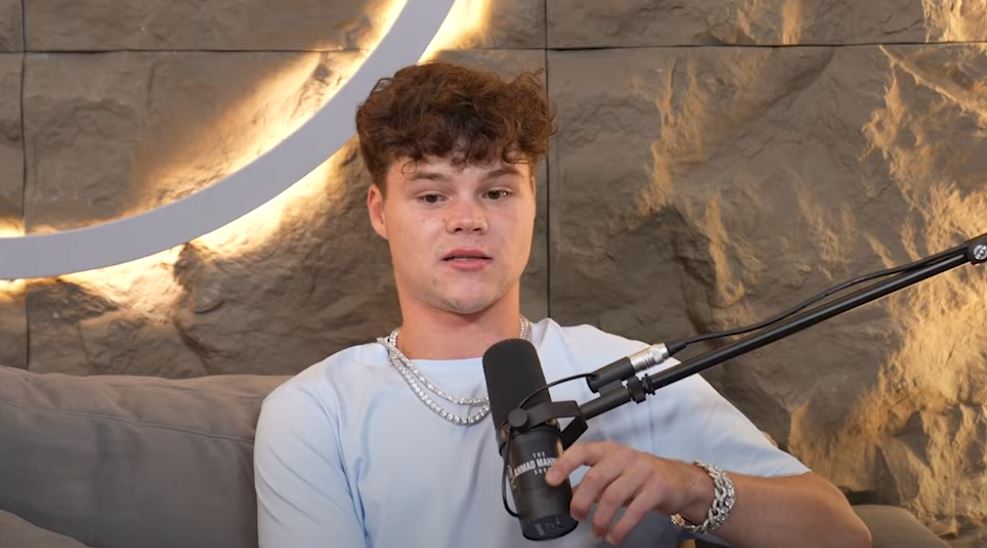Jack Doherty, who is only 21 years old, has built a digital empire that is incredibly successful at converting internet traffic into large sums of money. Doherty’s career is driven by spectacle, speed, and surprisingly clever monetization. He has amassed over 6 billion YouTube views and a multi-platform fan base. From livestreamed chaos to viral prank videos, he has constructed an identity that seems both reckless and oddly premeditated.
According to various sources, Doherty’s net worth has significantly increased over the last few years and is currently between $3 and $4 million. It took time to make this leap. His rise started with a low-budget trick that went viral in 2016—flipping markers on camera—which was surprisingly simple. That initial burst of online celebrity persisted. Instead, it developed into a string of consistently impressive stunts, each one considerably increasing his monthly income and getting more outrageous than the last.
Jack Doherty: Profile and Financial Summary
| Attribute | Details |
|---|---|
| Full Name | Jack Colin Doherty |
| Date of Birth | October 8, 2003 |
| Age | 21 (as of 2025) |
| Nationality | American |
| Heritage | Irish and Polish |
| Profession | YouTuber, Streamer |
| Notable Platforms | YouTube, Kick, TikTok |
| YouTube Subscribers | 15.3 million |
| YouTube Views | Over 6.27 billion |
| TikTok Following | More than 10 million |
| Estimated Net Worth | Between $3 million and $4 million |
| Main Income Sources | YouTube ads, Kick streaming, sponsorships, merchandise |
| Sponsored By | Nike, Adidas, Pepsi |
| Known Real Estate | Rents Miami mansion for $55,000/month |
| Education | North Shore High School graduate (2021) |
| Known For | Pranks, challenges, viral stunts |
| Legal Issues | Assault case (2024), Kick platform bans (2024–2025) |
| Past Relationship | McKinley Richardson (ended in 2025) |
Jack’s visibility increased by regularly posting energetic videos and working with other creators. Even though his material is controversial, it effectively captures and maintains viewers’ interest. Videos like “Singing on the Intercom” and “Floor Is Lava in Walmart” are designed to elicit immediate responses, shares, and clicks. Although his approach may seem disorganized, there is a formula: attention equals money.
Doherty expanded his brand to include profitable sponsorship deals through strategic alliances. Because of his edgier persona, many were surprised when major brands like Nike and Pepsi aligned themselves with his content. These partnerships have been especially helpful, giving his platform legitimacy and significantly boosting his company’s revenue.
Doherty’s spending patterns also highlight the value of monetized notoriety in the framework of influencer economics. He reinvests his money into the content that generates his revenue by renting a Miami mansion for $55,000 a month, hosting parties with Lil Baby and other celebrities, and flaunting expensive cars on livestreams. Every extravagant deed turns into content, and each video feeds his income cycle.
But over the past year, Doherty’s combative content style has had real-world repercussions. He was sued for assault and battery in October 2023 after a fight broke out at a Halloween party. Doherty allegedly encouraged his bodyguard to hit someone in the footage of the incident, which was streamed live and made money. More than just a personal obstacle, this lawsuit revealed the thin line separating online creators’ liability and performance.
Doherty maintained his popularity by capitalizing on controversy, despite criticism regarding safety and ethics. His business model has become extremely resilient and versatile, as evidenced by his ability to remain relevant in the face of platform bans. His following persisted even after he was kicked from Kick for breaking the rules twice, once for livestreaming a reckless driving incident and again following a street fight. Since then, he has tried out different platforms and even took advantage of brief unbans to advertise.
Doherty’s strategy is especially novel because he conflates risk, entertainment, and self-promotion. He didn’t let his broken collarbone from a botched stunt stop him; it just turned into another video. His content cycle includes bans, lawsuits, and injuries, which feed an audience that values show over authenticity. And this formula continues to work very well in a media environment that is fixated on immediacy.
Think about other artists who have comparable styles for comparison. Danny Duncan, who manages a multi-million dollar merchandise business, combines branding with stunts. FaZe Rug uses practical jokes to gain popularity and business agreements. Doherty is in the middle, too popular to be ignored but too edgy for complete mainstream acceptance. His development is so remarkably unusual because of this delicate balancing act.
Doherty has even alluded to more expansive business ventures in recent months, such as clothing lines and creator houses. His financial profile might change from that of an internet celebrity to that of an entrepreneurial force if these endeavors succeed. That change, which is already clearly in progress, shows that he is thinking more broadly than his disorganized content suggests.
Jack has been adamant since 2022 that virality is planned, not haphazard. Everything, including the timing of his edits and the selection of collaborators, contributes to a cycle that maximizes views and income. This deliberate chaos has turned out to be surprisingly long-lasting. Jack has developed a repeatable model driven by unpredictability, whereas many creators fade after one viral moment.
Whether or not his net worth keeps growing in the upcoming years will depend on his capacity to adjust to shifting platform policies and audience preferences. He’s incredibly well-positioned to change course fast, make money, and continue to be discussed in the culture, if past actions are any guide.




